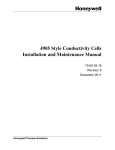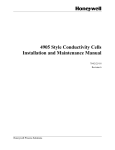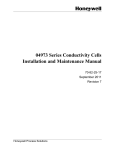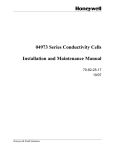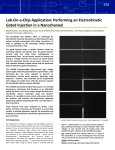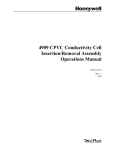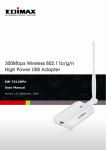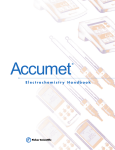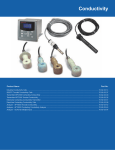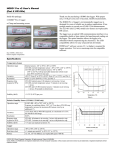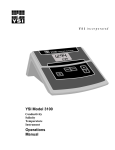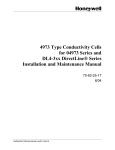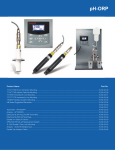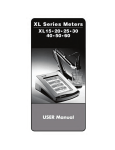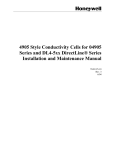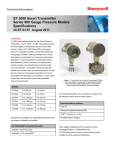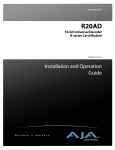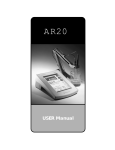Download Honeywell 4909 Stainless Steel Ball Valve/Insertion Mounting Users
Transcript
4909/4908 Style Conductivity Cell with 316SS Insertion/Removal Assembly Installation and Maintenance Manual 70-82-25-68 Rev. 4 June 2009 Honeywell Process Solutions Contents Copyright, Notices, and Trademarks Printed in U.S.A. – © Copyright 2007 by Honeywell Inc. Revision 4 – June 2009 While this information is presented in good faith and believed to be accurate, Honeywell disclaims the implied warranties of merchantability and fitness for a particular purpose and makes no express warranties except as may be stated in its written agreement with and for its customer. In no event is Honeywell liable to anyone for any indirect, special or consequential damages. The information and specifications in this document are subject to change without notice. Honeywell Process Solutions 512 Virginia Drive Fort Washington, PA 19034 ii 4909/4908 316SS Conductivity Cell Insertion/Removal Assembly June 09 Contents About This Document Abstract This document is intended to support the installation, operation and maintenance of the 4909/4908 Style Conductivity Cell with 316SS Insertion/Removel Assembly. Revision Notes The following list provides notes concerning all revisions of this document. Rev. ID Date Notes 0 2/87 This document is the initial Honeywell release of the L&N manual p/n 177770. There has been no significant changes made to this manual. The format has been changed to reflect the Honeywell layout and some part numbers have been changed to reflect Honeywell database structure. 1 6/99 Edits were made to make descriptions consistent and a new MSG was added. 2 7/06 Edits to Maintenance, Spare Parts, and Wiring 3 10/07 Edits to specifications, spart parts, wiring 4 June 09 Consolitation References Honeywell Documents The following list identifies all Honeywell documents that may be sources of reference for the material discussed in this publication. Document Title ID # UDA2182 Universal Dual Analyzer User Manual 70-82-25-119 APT2000CC Transmitter User Manual 70-82-25-95 APT4000CC Analyzer User Mnaual 70-82-25-104 Contacts World Wide Web http://hpsweb.honeywell.com Telephone Contact us by telephone at the numbers listed below. Organization United States and Canada June 09 Honeywell Phone Number 1-800-423-9883 4909/4908 316SS Conductivity Cell Insertion/Removal Assembly iii Contents Symbol Definitions The following table lists those symbols used in this document to denote certain conditions. Symbol Definition This CAUTION symbol on the equipment refers the user to the Product Manual for additional information. This symbol appears next to required information in the manual. WARNING PERSONAL INJURY: Risk of electrical shock. This symbol warns the user of a potential shock hazard where HAZARDOUS LIVE voltages greater than 30 Vrms, 42.4 Vpeak, or 60 Vdc may be accessible. Failure to comply with these instructions could result in death or serious injury. ATTENTION, Electrostatic Discharge (ESD) hazards. Observe precautions for handling electrostatic sensitive devices Protective Earth (PE) terminal. Provided for connection of the protective earth (green or green/yellow) supply system conductor. Functional earth terminal. Used for non-safety purposes such as noise immunity improvement. NOTE: This connection shall be bonded to protective earth at the source of supply in accordance with national local electrical code requirements. Earth Ground. Functional earth connection. NOTE: This connection shall be bonded to Protective earth at the source of supply in accordance with national and local electrical code requirements. Chassis Ground. Identifies a connection to the chassis or frame of the equipment shall be bonded to Protective Earth at the source of supply in accordance with national and local electrical code requirements. iv 4909/4908 316SS Conductivity Cell Insertion/Removal Assembly June 09 Contents Contents 1. INTRODUCTION ................................................................................................... 1 1.1 2. Description ..................................................................................................................................... 1 1.1.1 4908 Style Insertion Cell ..................................................................................................... 2 1.1.2 31741450 Removal Device ................................................................................................. 2 SPECIFICATIONS AND MODEL SELECTION GUIDE ........................................ 3 2.1 3. Specifications ................................................................................................................................. 3 INSTALLATION .................................................................................................... 4 3.1 Overview ........................................................................................................................................ 4 3.2 Location and Position ..................................................................................................................... 4 3.3 Preparing Insertion Tube Assembly ............................................................................................... 5 3.4 Installation Procedure..................................................................................................................... 6 4. ELECTRICAL CONNECTIONS .......................................................................... 11 4.1 Overview ...................................................................................................................................... 11 4.2 Instrument Wiring ........................................................................................................................ 11 4.2.1 Model 4909/4908 Series to UDA2182 Analyzer............................................................... 12 5. MAINTENANCE .................................................................................................. 15 5.1 Introduction .................................................................................................................................. 15 5.2 Cleaning the Cell .......................................................................................................................... 15 5.3 Platinizing the Cell Electrodes ..................................................................................................... 15 5.4 Reference Solutions of Known Conductivity............................................................................... 16 5.5 Leakage from Removal Device .................................................................................................... 16 5.6 Replacement Parts and Accessories ............................................................................................. 18 June 09 4909/4908 316SS Conductivity Cell Insertion/Removal Assembly v Contents Tables Table 1-1. Specific Conductance of Sample Solutions for Corresponding Measured Resistance Values... 2 Table 5-1 Voltage and Time Limits for Platinizing Cells........................................................................... 16 Table 5-2 Standard Reference Solutions..................................................................................................... 17 Table 5-3 Replacement Parts and Accessories ........................................................................................... 18 Figures Figure 1-1. 4909 Conductivity Cell Assembly Installed in 31741450 Removal Device ............................. 1 Figure 3-1 Recommended Locations for Mounting a Conductivity Cell...................................................... 5 Figure 3-2 Mounting the Retainer on the Mounting Tube............................................................................ 6 Figure 3-3 Cell Assembly Dimensions and Parts Identification ................................................................... 7 Figure 3-4 Outline and Dimension Drawing for Insertion/Removal Mounting and Cell with Junction Box8 Figure 3-5 Outline and Dimension Drawing for Insertion/Removal Mounting and Cell with Cable........... 9 Figure 4-1 Installation Diagram, 4909/4908 Cells, with junction box head connected to UDA2182 Analyzer............................................................................................................................................... 12 Figure 4-2 Installation Diagram, 4909/4908 Cells, with cable leads directly connected to UDA2182 Analyzer or connected to junction box ................................................................................................ 13 Figure 4-3 4909/4908 Series to APT Series Analyzer/Transformer .......................................................... 14 Figure 5-1 Details of Stuffing Box ............................................................................................................. 17 vi 4909/4908 316SS Conductivity Cell Insertion/Removal Assembly June 09 Introduction 1. Introduction 1.1 Description The stainless steel 4909 style conductivity cell assembly is designed for use in a pipe line or closed vessel where it is desirable to remove the cell for inspection and maintenance without shutting down the system and releasing the pressure. The assembly comprises a 4908 Insertion Cell and a 3131741450 Cell Removal Device which are shown assembled in Figure 1-1. It is to be used in applications for which maximum pressure does not exceed 200 psi and can be reduced to 50 psi during insertion and removal of the cell. Maximum operation temperature is determined by the temperature compensator range. Do not use in solutions above 284°F (140°C). The depth of insertion is 6-1/2 to 9 inches from the mounting nipple on the removal device. The entire insertion-cell assembly is made from polyethersulfone (PES) with Ryton support fittings, which is resistant to most corrosive inorganic chemicals over a wide range of temperatures. (A common exception is chlorinated hydrocarbons and ketones.) Sample solutions come into contact with the PES and the platinum, nickel or Monel electrode surface of the cell. ( Cell constant determines electrode material.) The only other materials of the 4909 Assembly with which the sample solution may come into contact are the stainless steel removal device, a stainless steel retainer ring and a Viton-A O-ring. Stuffing Box Valve Insertion Cell Valve Nipple Insertion Cell a/n 23562 Figure 1-1. 4909 Conductivity Cell Assembly Installed in 31741450 Removal Device CAUTION Specific parameters of your process may prohibit the use of nickel elements. For example, always use a platinum-element cell if the cell will measure or be exposed to regeneration acids (except the 0.1 cell constant, which is only supplied as Monel). ATTENTION Conductivity Cells are manufactured with an embedded EEProm that contains the cell constant and cell factor information. When the EEProm leads (Brown and Blue) , junction box head terminals (E) and (F) are connected to a UDA2182 Analyzer these parameters are automatically uploaded into the analyzer. June 09 4909/4908 316SS Conductivity Cell Insertion/Removal Assembly 1 Introduction 1.1.1 4908 Style Insertion Cell General The molded conductivity cell and its one-inch diameter mounting tube (with retaining ring) comprise a one piece cell unit and are made of polyethersulfone and Ryton. The retaining ring and an O-ring which secures it in a concentric groove in the cell mounting tube are supplied in place. This stainless steel ring serves as a stop during the removal operation. The retainer O-ring is Viton-A. The insertion cell is supplied with either 20 feet of PVC-sheathed cable, or an integral junction box head. Conductivity Cell The cells having constants of 10 and 50 cm-1 are intended for making measurements in highly conductive solutions. They differ in construction from those having constants of 0.01, 0.1, or 1cm-1. On the 50 constant cells, the electrodes are short tubes located midway inside the two parallel tubular channels that run lengthwise through the cell, and are open to the sample at both ends of the cell. The 0.01, 0.1, and 1.0 constant cells have a removable cell guard which is screwed onto the cell body to protect the electrode surfaces. Electrodes are three discs on the 1.0 constant cell, parallel plates on the 0.1 constant cell, and a pair of concentric wires wound on the cell body on the 0.01 constant cell. Cells must be used with the guard in place or the cell constant may differ from that specified. Table 1-1 lists the specific conductance possible with each of the cell constants. This table is provided for general information only, and is not needed for measurements. 1.1.2 31741450 Removal Device This device consists of a ball valve which is connected to the closed system by a 1-1/4 inch standard pipe thread mounting nipple and to a stuffing box by a 6-5/8 inch long special nipple into which the cell mounting tube is inserted. The stuffing box provides a seal around the cell mounting tube. The material used is 316 stainless steel. Table 1-1. Specific Conductance of Sample Solutions for Corresponding Measured Resistance Values Cell Constant 100 Ohms 10000 Ohms 50000 Ohms 0.01 100 μmho/cm 1 μmho/cm 0.2 μmho/cm 0.1 1000 μmho/cm 10 μmho/cm 2 μmho/cm 10000 μmho/cm 100 μmho/cm 20 μmho/cm 10 100000 μmho/cm 1000 μmho/cm 200 μmho/cm 50 500000 μmho/cm 5000 μmho/cm 1000 μmho/cm 1.0 Note: Table 1-1 has been provided for reference only. 2 4909/4908 316SS Conductivity Cell Insertion/Removal Assembly June 09 Specifications and Model Selection Guide 2. Specifications and Model Selection Guide 2.1 Specifications Cell Constants: Model 4909/4908: 0.01, 0.1, 1.0, 10, and 50 cm-1 Electrode Material: Nickel, Platinum, or Monel as specified Maximum Pressure Limit: 200 psi. @100°C -. For CRN Approval: 80 psig @140° C Maximum Temperature Limit: 140°C Mounting: 1-1/4” NPT male pipe. Insertion Depth: Varies between 6-1/2” and 9” nominal, depending upon cell constant. Wetted Parts: Immersed parts are: Polyethersulfone (PES) with Ryton support fittings, Viton A, 316 SS, and Nickel, Platinum or Monel electrode. Mounting materials are 316 Stainless Steel. Electrical Connections: Six leads with integral automatic temperature compensator. Leadwire: PVC covered, 22-gage cable, 20’ long, as specified. If more than 20’ required, use Universal Head Cast Aluminum Junction Box and appropriate length of cable. See Section 4 for options. Universal Heads are cast aluminum 3/4” female NPT with 1/2” NPT female adapter bushing, female conduit connection and terminals to accommodate cell and automatic temperature compensator connections. CRN Approvals: Manufactured to comply with ASME Boiler and Pressure Vessel Code , Section III, Div 1, UG-101. CRN # 0F11607.5C Weight: 20 lb. (9.1 kg). June 09 4909/4908 316SS Conductivity Cell Insertion/Removal Assembly 3 Installation 3. Installation 3.1 Overview To insure that a representative sample is being measured at all times, the solution must move through the cell channels or guard tube. If the measurement is made in a rapidly moving liquid, the existing circulation of the solution can be utilized by mounting the assembly as described in the next section so that the flow of the solution forces liquid through the cell. However, when measurements are to be made in quiescent solutions, means must be provided for forcing the solution through the conductivity cell or care taken to place the cell in a position to “see” the true value of the solution. Do not use the cells in solutions which will attack the fittings used or the cell materials. The PES and platinum, nickel or Monel of the electrode, the stainless-steel retainer, and the Viton A retainer O-ring are the cell materials with which the solution will come into contact. The removal device is 316 stainless steel. Do not use the cell in a solution having temperatures greater than 140°C. The maximum limit set by the temperature compensator range must be observed. For cells having a constant of 0.01, 0.1 or 1, make certain that the guard is in place and is not loose on the cell body. The guard tube must be hand-tightened only. There is a 1/16 inch space between the guard tube and the cell body. Although the cell has excellent shock resistance characteristics, never subject it to mechanical abuse. ATTENTION Conductivity cells have an EEPROM device for automatic download of cell constant and cell calibration factor. During installation proper ESD protection is required so the memory device is not damaged. WARNING For 6 conductor cells, EEPROM memory device is ESD sensitive- blue and brown leads; junction box head terminals (E) and (F) 3.2 Location and Position The cross-channel in the high constant cells or the guard tube holes in the low constant cells must be covered by the solution during measurements. Vertical insertion (from above) or horizontal insertion can be used. Make certain the tank or pipe line is full under all process conditions. If a pipe line is not always full, use a vertical mounting as in Figure 3-1and insert the cell far enough into the vertical pipe that the cross-channel is below the horizontal exit pipe which may empty out. Make certain an air bubble in the pipe does not prevent the cell from filling properly. (If the cell becomes dry after use, it may require cleaning in accordance with Section 5.2 before again being placed in service.) For best results, whether vertical or horizontal mounting is used, position the cell so that the sample will flow through the channels or guard tube towards the mounting end of the cell, exiting through the crosschannel or guard-tube holes. In applications where vertical mounting is required, avoid a position with the cell channels pointed up, as this will permit solution to flow down into the open end of the cell and may result in clogging by solids settling in the cell channels. 4 4909/4908 316SS Conductivity Cell Insertion/Removal Assembly June 09 Installation Allow for a total insertion depth of about ten inches from the outside wall of the mounting surface as indicated by the dimensions in Figure 3-4. Allow at least one-half inch clearance beyond the end of the cell and 1/8 to 3/16 inch radius clearance surrounding the cell to permit circulation of the solution. If not part of the cell assembly, place the temperature compensator close enough to the cell to eliminate a significant temperature difference in the liquid between the two points. If necessary, lag the pipe between the two points to prevent rapid cooling. Avoid locations where excessive temperature changes may occur. Allow at least 30 inches clearance behind the stuffing box to permit removal. Locate the insertion assembly on the pressure side of pumps; not the vacuum side. Avoid locations where the operator must take an awkward position to perform the cell insertion or removal operation. Figure 3-1 illustrates recommendations for locating and mounting both the cell assembly and the temperature compensator. Refer to Figure 3-3, Figure 3-4, or Figure 3-5 for mounting dimensions. Preferred Cell Locations Process Cooler 1.5" Pump a/n 23563 Figure 3-1 Recommended Locations for Mounting a Conductivity Cell 3.3 Preparing Insertion Tube Assembly June 09 1. Take out the forward screw (valve end) of the stuffing box and unscrew the box from the valve nipple. 2. Slide the insertion tube into the smaller opening in the stuffing box, while holding in the washer, gland ring, and compression seal. 3. Roll the O-ring over the end of the insertion tube and into the concentric groove. Use a small screwdriver or pointed object to pry out a side of the O-ring and stretch it about one inch from the tube to reduce its cross section. Insert the U-shaped retaining ring in the slot. Figure 3-2 illustrates this operation. With the grooved side of the retainer against the O-ring, press the retainer in on one side while pulling on the O-ring from the opposite side as shown. Rotate the retainer back and forth until all of the stretched slack is taken back into the slot. Make certain the retainer is pushed all the way in. 4909/4908 316SS Conductivity Cell Insertion/Removal Assembly 5 Installation a/n 23567 Figure 3-2 Mounting the Retainer on the Mounting Tube 3.4 Installation Procedure ATTENTION Before making the initial installation, remove the stuffing box, slide the mounting tube through the unthreaded end of the box and slide the retaining ring in place on the tube in accordance with the procedure outlined below. Insertion 1. Remove both knurled screws from the stuffing box and slide the insertion tube into the valve nipple. 2. Screw the stuffing box onto the nipple and tighten the forward knurled screw all the way down. Hand tighten the stuffing box so that the tube slides stiffly when pushed. 3. Reduce process pressure to 50 psig or less. Open the valve. 4. Push the insertion tube all the way in and tighten the back knurled screw on the stuffing box all the way down. Note that the shoulder on the tube must be sealed in the stuffing box before the lock screw is tightened. 5. Hand tighten the stuffing box and return the process to normal operating pressure. Removal 6 1. Reduce process pressure to 50 psig or less. 2. Remove the back knurled screw on the stuffing box. (If the tube moves back, apply slight force to let it slide out slowly.) 3. Allow the tube assembly to be forced out to its stop and close the valve. (If necessary, turn the stuffing box very slightly.) 4. Remove the other knurled screw and unscrew the stuffing box to remove it. 4909/4908 316SS Conductivity Cell Insertion/Removal Assembly June 09 Installation Retainer O-Rin O-Ring Retaining Ring 2.9" (73.7mm) Stuffing Box Valve Nipple 4.00" (101.6mm) Approx. 14.5" (368.3mm) Mounting Tube Allowa minimumof 30" (762mm) clearance beyondthis point for removal. Figure 3-3 Cell Assembly Dimensions and Parts Identification June 09 4909/4908 316SS Conductivity Cell Insertion/Removal Assembly 7 Installation Figure 3-4 Outline and Dimension Drawing for Insertion/Removal Mounting and Cell with Junction Box Head 8 4909/4908 316SS Conductivity Cell Insertion/Removal Assembly June 09 Installation Figure 3-5 Outline and Dimension Drawing for Insertion/Removal Mounting and Cell with Cable June 09 4909/4908 316SS Conductivity Cell Insertion/Removal Assembly 9 Electrical Connections 4. Electrical Connections 4.1 Overview The terminal-board connections for recorder or analyzer are given in the appropriate directions furnished with the measuring instrument. To avoid the possibility of ac pick-up in the cell leads, separate them from all ac line-voltage wiring or run them in a separate grounded conduit. WARNING For 6 conductor cells, EEPROM memory device is ESD sensitive- blue and brown leads; junction box head terminals (E) and (F) June 09 4909/4908 316SS Conductivity Cell Insertion/Removal Assembly 11 Electrical Connections 4.2 Instrument Wiring 4.2.1 Model 4909/4908 Series to UDA2182 Analyzer Drawing 50043652 Figure 4-1 Installation Diagram, 4909/4908 Cells, with junction box head connected to UDA2182 Analyzer 12 4909/4908 316SS Conductivity Cell Insertion/Removal Assembly June 09 Electrical Connections Drawing 50043654 Figure 4-2 Installation Diagram, 4909/4908 Cells, with cable leads directly connected to UDA2182 Analyzer or connected to junction box June 09 4909/4908 316SS Conductivity Cell Insertion/Removal Assembly 13 Electrical Connections Brown and Blue wires not used 04905 series cells with 20’ leads 04905 series cells with cable leadsconnected connectedtotoananAPT4000 APT4000 Brown and Blue wires not used 04905 series cells with or 20’ leads connected APT2000 04905 series cells with cable leads connected totoananAPT2000 Figure 4-3 4909/4908 Series to APT Series Analyzer/Transformer 14 4909/4908 316SS Conductivity Cell Insertion/Removal Assembly June 09 Maintenance 5. Maintenance 5.1 Introduction If a series of below-normal readings occurs, this may indicate poor response because the cell is not filled with process solution. Check the cell installation. Note that a grayish dull surface on the cell plastic (normally glassy) can result from exposure to temperatures above 140°C. The only maintenance which may be required is occasional cleaning in certain applications. The low constant electrodes are not platinized. To remove or replace the cell, refer to Section 1. NOTE: Never connect a test instrument across the Blue (E) and Brown (F) leads. Damage to the cell memory device may occur. 5.2 Cleaning the Cell CAUTION The cell housing is PES (polyethersulfone). Do not clean with acetone, chloroform, toluene, benzene, or any other chlorinated hydrocarbon. The cell will require cleaning if sludge, slime, etc., accumulates in the flow channels. Since the materials of construction are chemically inert, chemical agents may be used and are recommended for cleaning the cells. The particular cleaning agent used must be selected according to the type of contamination to which the cell is exposed. In general, soap and hot water cleaning solution is effective. Immerse the plastic body of the cell in this solution. A 10 or 15 minute soaking period should be adequate. If necessary, a soft bristle brush of about 1/4 inch diameter may be used to clean out the tubular channels of the 10 and 50 constant cells. Care must be taken not to scratch the electrode surfaces. Do not use a brush on the low (0.01, 0.1 and 1) constant cells and be especially careful not to bend the electrode plates of the 0.1 constant cell. Rinse the cell thoroughly in tap water and then in distilled water if available. To remove the platinum black from electrodes (10 and 50 constants only), refer to Section 5.3 Replatinizing after each cleaning (10 and 50 constant cells only), may not be necessary unless brushing was used. 5.3 Platinizing the Cell Electrodes Only the electrodes having constants 10 and 50 must be replatinized if the velvety-black deposit has been rubbed off the electrodes in service or in cleaning or if platinized electrodes are recommended and this black deposit is not present when the new cell is received. Always replatinize if a brush was used in cleaning the electrodes. The indication of a need for replatinization of the electrodes is loss in sensitivity (slow response of measuring instrument), erratic behavior of measuring instrument, or difficulty in balancing. The electrodes of the high constant cells are not visible since they are located near the middle of the flow channels. Therefore the need for platinization is only indicated by the effect on the measuring instrument. Do not platinize cells intended for high purity water measurements. Before platinizing, clean the cell with detergent and brush as described in Section 5.2. Support the cell in a cylindrical vessel with the end of the cell raised from the bottom. It is not necessary to remove the cell from the fittings for platinizing. However, the guard tube must be removed from the low constant cells. Pour in a platinizing solution to a level above the cross-channel. To platinized the 10 or 50 constant cells, immerse an auxiliary platinum electrode in the solution to a point about midway between the cross-channel or tube hole and the open end of the cell. (This third electrode should be chemically pure platinum. Its shape is unimportant. It may be one of the electrodes in another June 09 4909/4908 316SS Conductivity Cell Insertion/Removal Assembly 15 Maintenance conductivity cell or a platinum strip, sheet, rod, wire, etc.) Both electrodes of the cell are platinized simultaneously by connecting the negative terminal of the battery (see Table 5-1) to both leadwires of the cell. Connect the positive terminal of the battery to the auxiliary platinum electrode. Note the time lapse and continue the platinizing operation for the time in seconds listed in Table 5-1. Then disconnect the battery and remove the cell. Rinse the cell thoroughly in tap water and then rinse in distilled water. During the platinizing operation, move the cell up and down gently to keep the solution stirred. CAUTION The preceding procedure produces a barely visible coating of platinum black on the electrode surfaces. Do not attempt to darken electrodes by additional platinization since this will affect the cell performance adversely. Pour the platinizing solution back into its container as it may be used a number of times. If the cell is not to be installed immediately after platinizing, it should be kept submerged in distilled water until put into use, as platinum black is not stable when dry. Table 5-1 Voltage and Time Limits for Platinizing Cells DC 10 50 Volts 6.0 100 sec. 300 sec. 12.0 ---- 240 sec. 5.4 Reference Solutions of Known Conductivity To check the system comprising conductivity cell, leadwire, and measuring instrument, the user may desire to make a measurement in a reference solution of known conductivity. Table 5-2 defines the standard solutions and lists their conductivity. Control the temperature only within limits consistent with the desired accuracy. The 25°C temperature value is suggested. For cell constants less than 10 use a good known reference solution from a laboratory supply vendor. 5.5 Leakage from Removal Device Do not use excessive force when tightening the stuffing box as this may distort the end of the valve nipple on which the stuffing box is mounted. Leakage which cannot be stopped by normal tightening of the stuffing box may be corrected if the plastic washer is renewed See Figure 5-1. If not, the leakage may have been caused by slight distortion of the mating surfaces of the nipple and gland ring. If these surfaces are cleaned, the sliding fit will be improved; distortion and its resulting leaks will be prevented. To clean the mating surfaces between the gland ring and the nipple, first remove the stuffing box and take out the gland ring. Clean the surfaces with a flat, fine sandstone, changing the direction of stroke about 15 degrees per stroke to keep the surfaces parallel. 16 4909/4908 316SS Conductivity Cell Insertion/Removal Assembly June 09 Maintenance Valve Stuffing Box Mounting Nipple Valve Nipple Insertion Cell Cell Guard Tube Plastic Washer Figure 5-1 Details of Stuffing Box Table 5-2 Standard Reference Solutions Approximate Normality 1.0 N June 09 Definition 71.1352 grams KC1 per 1000 grams of water O Temp C 0 18 25 Specific Conductance (micromhos) 65,176 97,838 111,342 4909/4908 316SS Conductivity Cell Insertion/Removal Assembly Nominal Constant of Cell to be Checked 10, 50 17 Maintenance 5.6 Replacement Parts and Accessories Replacement parts and accessories are listed in Table 5-3. Table 5-3 Replacement Parts and Accessories Description Part No. Retainer Ring 31027158 Retainer O-Ring 31082053 Complete Removal Device 316 Stainless Steel without Cell Assembly 31741450 Short Mounting Nipple, 1-1/4” NPT 316 Stainless Steel 31020953 Ball Valve 316 Stainless Steel 31020868 Long Valve Nipple 316 Stainless Steel 31076635 316 Stainless Steel Stuffing Box (does not include following parts) 31500697 316 Stainless Steel Gland Ring (between packing and plastic washer) 31001215 Safety Chain Monel and Brass 31500464 Compression Seal (Viton) 31071494 Viton Washer (covers gland ring) 31301277 Cell Extension Leadwire (see Fig 4.1 & 4.2 for required cables) 18 18 AWG, Low capacitance shielded twisted pair BELDEN 8760 or equivalent 22 AWG, Coax RG59U BELDEN 9259 or equivalent 18 AWG, 4 conductor BELDEN 8489 or equivalent 4909/4908 316SS Conductivity Cell Insertion/Removal Assembly June 09 Maintenance June 09 4909/4908 316SS Conductivity Cell Insertion/Removal Assembly 19 Honeywell Process Solutions 512 Virginia Drive Fort Washington, PA 19034 70-82-25-68 June 09 Printed in USA www.honeywell.com/ps


























